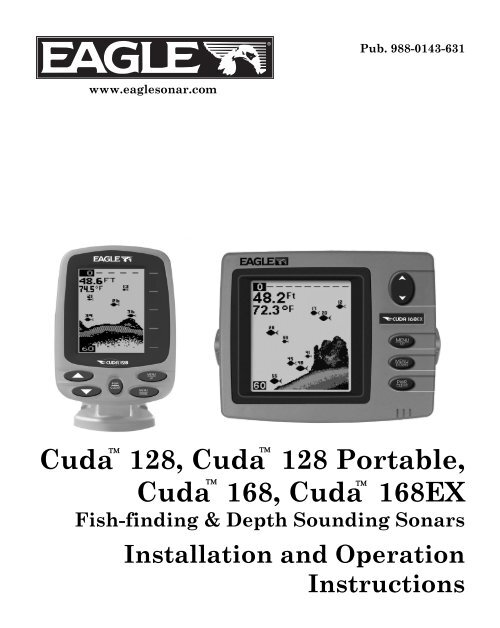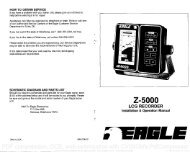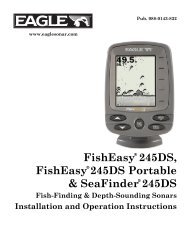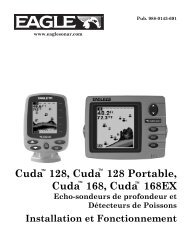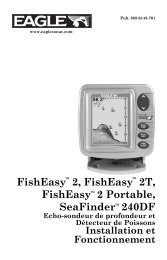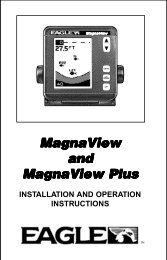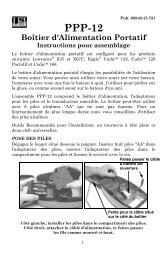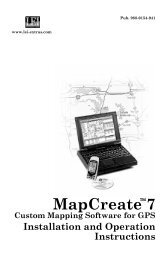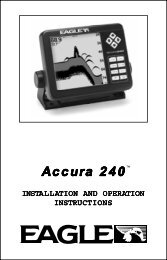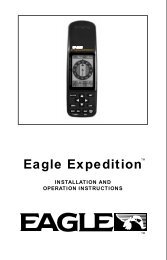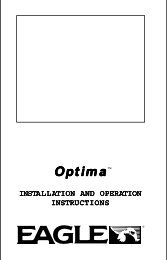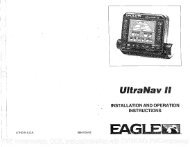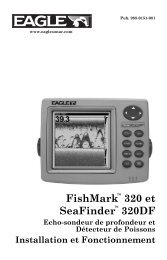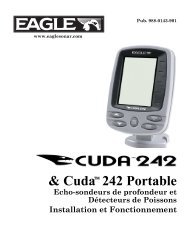Cuda 128 Owner's Manual - Eagle
Cuda 128 Owner's Manual - Eagle
Cuda 128 Owner's Manual - Eagle
Create successful ePaper yourself
Turn your PDF publications into a flip-book with our unique Google optimized e-Paper software.
www.eaglesonar.com<br />
Pub. 988-0143-631<br />
<br />
<br />
<strong>Cuda</strong> <strong>128</strong>, <strong>Cuda</strong> <strong>128</strong> Portable,<br />
<br />
<br />
<strong>Cuda</strong> 168, <strong>Cuda</strong> 168EX<br />
Fish-finding & Depth Sounding Sonars<br />
Installation and Operation<br />
Instructions
Copyright © 2002 <strong>Eagle</strong> Electronics<br />
All rights reserved.<br />
<strong>Eagle</strong> ® is a registered trademark of <strong>Eagle</strong> Electronics<br />
Marine-Tex is a trademark of Illinois Tool Works Inc.<br />
<strong>Eagle</strong> Electronics may find it necessary to change or end our policies,<br />
regulations, and special offers at any time. We reserve the right to do so<br />
without notice. All features and specifications subject to change without<br />
notice. All screens in this manual are simulated.<br />
For free owner's manuals and other information,<br />
visit our web site:<br />
www.eaglesonar.com<br />
<strong>Eagle</strong> Electronics<br />
P.O. Box 669<br />
Catoosa, OK USA 74015<br />
Printed in USA.
Table of Contents<br />
Introduction ............................................................................... 1<br />
Capabilities and Specifications: <strong>Cuda</strong> Family ......................... 1<br />
Installation Preparations ............................................................. 3<br />
Transducer Installation........................................................... 4<br />
Recommended Tools and Supplies ........................................... 4<br />
Selecting a Transducer Location.............................................. 5<br />
Shoot-Thru-Hull vs. Transom Mounting ................................. 7<br />
Transom Transducer Assembly and Mounting ....................... 7<br />
Trolling Motor Bracket Installation....................................... 12<br />
Transducer Orientation and Fish Arches .............................. 12<br />
Shoot-Thru-Hull Preparation and Installation ..................... 14<br />
Power and Cable Connections.................................................... 16<br />
Mounting the Sonar Unit: In-Dash or Bracket ......................... 18<br />
In-Dash Installation ............................................................... 18<br />
Bracket Installation................................................................ 21<br />
Portable Sonar Installation........................................................ 25<br />
Operation ..................................................................................30<br />
Keyboard Basics.......................................................................... 30<br />
PWR/Clear (Power and Clear)................................................ 30<br />
Menu Up and Menu Down ..................................................... 30<br />
Up and Down Arrows.............................................................. 31<br />
Memory........................................................................................ 31<br />
Menus .......................................................................................... 31<br />
Display – Opening Screen .......................................................... 32<br />
Chart Scroll (Stopping and Starting)......................................... 33<br />
Full Chart.................................................................................... 34<br />
Depth Range Zoom (Automatic and <strong>Manual</strong>)............................ 35<br />
Zoom ............................................................................................ 36<br />
Sensitivity ................................................................................... 37<br />
Grayline ® ..................................................................................... 40<br />
Fish I.D. ................................................................................... 41<br />
i
FishTrack................................................................................. 43<br />
Chart Scroll Speed ...................................................................... 44<br />
Noise Reject and ASP (Advanced Signal Processing) ............ 44<br />
Alarms ......................................................................................... 45<br />
Fish Alarm............................................................................... 45<br />
Depth Alarms .......................................................................... 46<br />
Shallow Alarm......................................................................... 46<br />
Deep Alarm ............................................................................. 46<br />
Display Adjustments .................................................................. 47<br />
Backlights................................................................................ 47<br />
Display Contrast ..................................................................... 47<br />
Depth Units of Measure ............................................................. 48<br />
Preset Unit (Reset All Options).................................................. 48<br />
System Info ................................................................................. 48<br />
Simulator..................................................................................... 48<br />
Digital Data Size for Depth and Temperature.......................... 49<br />
Troubleshooting ......................................................................50<br />
Warranty and Service Information.....................................57<br />
ii
Introduction<br />
Thank you for buying an <strong>Eagle</strong> ® sonar! Your unit is a high-quality<br />
sonar designed for both professional and novice fishermen. All <strong>Eagle</strong><br />
sonars have an automatic mode that finds and displays the bottom,<br />
fish, underwater structure and more – right out of the box. All you have<br />
to do is press the on (PWR) key.<br />
However, if you want to fine-tune your unit, press the MENU UP key. The<br />
sonar has several powerful features you can control by scrolling through<br />
easy-to-use menus with the arrow and menu keys.<br />
To get started with your <strong>Eagle</strong> sonar, first read the installation section.<br />
It contains instructions for mounting the sonar unit and the transducer.<br />
Following recommended installation practices will pay off in optimum<br />
performance of your <strong>Eagle</strong> sonar. Improper installation can cause<br />
problems down the road, especially if the transducer is badly mounted.<br />
After you've read the installation instructions, install the unit and<br />
accessories. Then, read the rest of the manual. The more you know<br />
about your sonar, the better it will work for you.<br />
Take advantage of the Simulator feature. It allows you to practice<br />
operating your sonar before you get it in the water. And when you finally<br />
head for your favorite fishing hole, take this manual along for reference.<br />
Capabilities and Specifications: <strong>Cuda</strong> Family<br />
General<br />
Case size: ..........................<strong>Cuda</strong> <strong>128</strong> and <strong>Cuda</strong> 168: 5.8" H x 4.3" W x<br />
2.5" D (14.7 cm H x 10.8 cm W x 6.6 cm D).<br />
<strong>Cuda</strong> 168EX: 5.4" H x 6.9" W x 3.4" D (13.8<br />
cm H x 17.6 cm W x 8.6 cm D).<br />
Sealed, waterproof; suitable for saltwater use.<br />
Display:............................ High-contrast Film SuperTwist LCD.<br />
Diagonal viewing area:<br />
<strong>Cuda</strong> <strong>128</strong> and <strong>Cuda</strong> 168: 4.0" (10.2 cm).<br />
<strong>Cuda</strong> 168EX: 4.5" (11.4 cm).<br />
1
Resolution:...................... <strong>Cuda</strong> <strong>128</strong> and <strong>Cuda</strong> <strong>128</strong> Portable:<br />
<strong>128</strong> pixels (vert.) x 65 pixels (horiz.)<br />
resolution; 8,320 total pixels.<br />
<strong>Cuda</strong> 168 and <strong>Cuda</strong> 168 EX:<br />
168 pixels (vert.) x 132 pixels (horiz.)<br />
resolution; 22,176 total pixels.<br />
Backlighting:.................. Backlit screen and keypad for night use.<br />
Input power:................... 10 to 17 volts DC.<br />
Current drain: ............... 110 ma lights off; 250 ma lights on.<br />
Back-up memory: .......... Built-in memory stores sonar settings when<br />
unit is turned off.<br />
Sonar<br />
Frequency:...................... 200 kHz.<br />
Transducers: .................. A Skimmer ® transducer comes packed with<br />
your sonar unit. Its 20° cone angle offers a<br />
wide fish detection area of up to 60º with<br />
high sensitivity settings. Operates at boat<br />
speeds up to 70 mph (61 kts).<br />
Transmitter: ................... 800 watts peak-to-peak; 100 watts RMS.<br />
Sonar sounding<br />
depth capability: ........... 600 feet (180 meters). Actual capability<br />
depends on transducer configuration and<br />
installation, bottom composition and water<br />
conditions. All sonar units typically read<br />
deeper in fresh water than in salt water.<br />
Depth display:................ Continuous digital readout.<br />
Audible alarms: ............. Deep/shallow/fish.<br />
Automatic ranging:....... Yes.<br />
Auto bottom track:........ Yes.<br />
Zoom bottom track: ...... Yes.<br />
Surface water temp: ..... Yes.<br />
2
NOTICE!<br />
The storage and operation temperature range for your unit is from<br />
-4 degrees to +167 degrees Fahrenheit (-20 degrees to +75 degrees<br />
Celsius). Extended storage or operation in temperatures higher or<br />
lower than specified will damage the liquid crystal display in your<br />
unit. This type of damage is not covered by the warranty. For more<br />
information, contact the factory's Customer Service Department;<br />
phone numbers are inside the manual's back cover.<br />
Installation Preparations<br />
You can install the sonar system in some other order if you prefer, but<br />
we recommend this installation sequence:<br />
Caution:<br />
You should read over this entire installation section before<br />
drilling any holes in your vessel!<br />
1. Determine the approximate location for the sonar unit, so you can<br />
plan how and where to route the cables for the transducer and power.<br />
This will help you make sure you have enough cable length for the<br />
desired configuration.<br />
2. Determine the approximate location for the transducer and its cable<br />
route.<br />
3. Determine the location of your battery or other power connection,<br />
along with the power cable route.<br />
4. Install the transducer and route the transducer cable to the sonar<br />
unit.<br />
5. Install the power cable and route it to the sonar unit.<br />
6. Mount the sonar unit.<br />
3
Transducer Installation<br />
These instructions will help you install your Skimmer ® transducer on a<br />
transom, on a trolling motor or inside a hull. Please read all<br />
instructions before proceeding with any installation.<br />
Your Skimmer transducer typically comes packaged with a one-piece<br />
stainless steel bracket for mounting it to the transom of your boat. The<br />
optional trolling motor mount uses a one-piece plastic bracket with an<br />
adjustable strap. These are "kick-up" mounting brackets. They help<br />
prevent damage if the transducer strikes an object while the boat is<br />
moving. If the transducer does "kick-up," the bracket can easily be<br />
pushed back into place without tools.<br />
Read these instructions carefully before attempting the installation.<br />
Determine which of the installation methods is right for your boat.<br />
Remember, the transducer installation is the most critical part<br />
of a sonar installation.<br />
Recommended Tools and supplies<br />
If you prefer the option of routing the cable through the transom, you will<br />
need a 5/8" drill bit. The following installation types also call for these<br />
recommended tools and required supplies (supplies are not included):<br />
Transom installation<br />
Tools include: two adjustable wrenches, drill, #29 (0.136") drill bit, flathead<br />
screwdriver. Supplies: high quality, marine grade above- or belowwaterline<br />
caulking compound.<br />
Trolling motor installations<br />
Tools: two adjustable wrenches, flat-head screwdriver. Supplies: plastic<br />
cable ties.<br />
Shoot-through hull installations<br />
Tools: these will vary depending on your hull's composition. Consult your<br />
boat dealer or manufacturer. Supplies: 100 grit sandpaper, good quality<br />
epoxy adhesive.<br />
4
Selecting a Transducer Location<br />
1. The transducer must be placed in a location that has a smooth flow of<br />
water at all times. If the transducer is to be mounted inside the hull,<br />
then the chosen location must be in the water at all times. If the<br />
transducer is not placed in a smooth flow of water, interference<br />
caused by bubbles and turbulence will show on the sonar's display in<br />
the form of random lines or dots whenever the boat is moving.<br />
NOTE:<br />
Some aluminum boats with strakes or ribs on the outside of the<br />
hull create large amounts of turbulence at high speed. These boats<br />
typically have large outboard motors capable of propelling the boat<br />
at speeds faster than 35 mph. Typically, a good location on<br />
aluminum boats is between the ribs closest to the engine.<br />
2. The transducer should be installed with its face pointing straight<br />
down, if possible.<br />
3. If the transducer is mounted on the transom, make sure it doesn't<br />
interfere with the trailer or hauling of the boat. Also, don't mount it<br />
closer than approximately one foot from the engine's lower unit. This<br />
will prevent cavitation (bubble) interference with propeller operation.<br />
4. If possible, route the transducer cable away from other wiring on the<br />
boat. Electrical noise from engine wiring, bilge pumps and aerators<br />
can be displayed on the sonar's screen. Use caution when routing the<br />
transducer cable around these wires.<br />
5
CAUTION: Clamp the<br />
transducer cable to transom<br />
near the transducer. This will<br />
help prevent the transducer<br />
from entering the boat if it is<br />
knocked off at high speed.<br />
Good<br />
location<br />
Poor angle Good location<br />
Good and poor transducer locations.<br />
How low should you go?<br />
For most situations, you should install your Skimmer transducer so<br />
that its centerline is level with the bottom of the boat hull. This will<br />
usually give you the best combination of smooth water flow and<br />
protection from bangs and bumps.<br />
Transducer<br />
centerline<br />
Poor location<br />
Align transducer centerline with hull bottom.<br />
However, there are times when you may need to adjust the transducer<br />
slightly higher or lower. (The slots in the mounting brackets allow you<br />
6<br />
Good location<br />
Transom<br />
Hull bottom
to loosen the screws and slide the transducer up or down.) If you<br />
frequently lose bottom signal lock while running at high speed, the<br />
transducer may be coming out of the water as you cross waves or<br />
wakes. Move the transducer a little lower to help prevent this.<br />
If you cruise or fish around lots of structure and cover, your transducer<br />
may be frequently kicking up from object strikes. If you wish, you may<br />
move the transducer a little higher for more protection.<br />
There are two extremes you should avoid. Never let the edge of the<br />
mounting bracket extend below the bottom of the hull. Never let the<br />
bottom – the face – of the transducer rise above the bottom of the hull.<br />
Shoot-thru-hull vs. Transom Mounting<br />
Typically, shoot-thru-hull installations give excellent high speed<br />
operation and good to excellent depth capability. There is no possibility<br />
of damage from floating objects. It can't be knocked off when docking or<br />
loading on the trailer.<br />
However, the shoot-thru-hull installation does have its drawbacks.<br />
First, some loss of sensitivity does occur, even on the best hulls. This<br />
varies from hull to hull, even from different installations on the same<br />
hull. This is caused by differences in hull lay-up and construction.<br />
Second, the transducer angle cannot be adjusted for the best fish<br />
arches. This can be a problem on some hulls that sit with the bow high<br />
when at rest or at slow trolling speeds. Follow the procedure listed in<br />
the shoot-thru-hull installation section at the end of this lesson to<br />
determine if you can satisfactorily shoot through the hull.<br />
TRANSOM TRANSDUCER ASSEMBLY AND MOUNTING<br />
The best way to install the transducer is to loosely assemble all of the<br />
parts first, place the transducer's bracket against the transom and see if<br />
you can move the transducer so that it's parallel with the ground.<br />
1. Assembling the bracket. Press the two small plastic ratchets into the<br />
sides of the metal bracket as shown in the following illustration. Notice<br />
7
there are letters molded into each ratchet. Place each ratchet into the<br />
bracket with the letter "A" aligned with the dot stamped into the metal<br />
bracket. This position sets the transducer's coarse angle adjustment for a<br />
14° transom. Most outboard and stern-drive transoms have a 14° angle.<br />
Align plastic ratchets in bracket.<br />
2. Aligning the transducer on the transom. Slide the transducer<br />
between the two ratchets. Temporarily slide the bolt though the<br />
transducer assembly and hold it against the transom. Looking at the<br />
transducer from the side, check to see if it will adjust so that its face<br />
is parallel to the ground. If it does, then the "A" position is correct for<br />
your hull.<br />
If the transducer's face isn't parallel with the ground, remove the<br />
transducer and ratchets from the bracket. Place the ratchets into the<br />
holes in the bracket with the letter "B" aligned with the dot stamped<br />
in the bracket.<br />
Reassemble the transducer and bracket and place them against the<br />
transom. Again, check to see if you can move the transducer so it's<br />
parallel with the ground. If you can, then go to step 3. If it doesn't,<br />
repeat step 2, but use a different alignment letter until you can place<br />
the transducer on the transom correctly.<br />
8<br />
Dot
Ratchets<br />
Insert bolt and check transducer position on transom.<br />
3. Assembling the transducer. Once you determine the correct<br />
position for the ratchets, assemble the transducer as shown in the<br />
following figure. Don't tighten the lock nut at this time.<br />
Nut<br />
Rubber<br />
washers<br />
Metal<br />
washer<br />
Bolt<br />
Assemble transducer and bracket.<br />
4. Drilling mounting holes. Hold the transducer and bracket assembly<br />
against the transom. The transducer should be roughly parallel to the<br />
ground. The transducer's centerline should be in line with the bottom<br />
of the hull. Don't let the bracket extend below the hull!<br />
Mark the center of each slot for the mounting screw pilot holes. You<br />
will drill one hole in the center of each slot.<br />
Drill the holes using the #29 bit (for the #10 screws).<br />
9<br />
Metal washer
Transom<br />
Transom<br />
Position transducer mount on transom and mark mounting holes.<br />
Side view shown at left and seen from above at right.<br />
5. Attaching transducer to transom. Remove the transducer from<br />
the bracket and re-assemble it with the cable passing through the<br />
bracket over the bolt as shown in the following figures.<br />
Route cable over bolt and through bracket. Side view shown at left and<br />
seen from above at right.<br />
Attach the transducer to the transom. Slide the transducer up or<br />
down until it's aligned properly with the bottom of the hull as shown<br />
in the preceding and following figures. Tighten the bracket's<br />
mounting screws, sealing them with the caulking compound.<br />
Adjust the transducer so that it's parallel to the ground and tighten<br />
the nut until it touches the outer washer, then add 1/4 turn. Don't<br />
over tighten the lock nut! If you do, the transducer won't "kick-up" if<br />
it strikes an object in the water.<br />
10
Bottom<br />
of<br />
hull<br />
Flat-bottom hull<br />
Deep-"vee" hull<br />
Align transducer centerline with hull bottom and attach to transom.<br />
6. Route the transducer cable through or over the transom to<br />
the sonar unit. Make sure to leave some slack in the cable at the<br />
transducer. If possible, route the transducer cable away from other<br />
wiring on the boat. Electrical noise from the engine's wiring, bilge<br />
pumps, VHF radio wires and cables, and aerators can be picked up by<br />
the sonar. Use caution when routing the transducer cable around<br />
these wires.<br />
WARNING:<br />
Clamp the transducer cable to the transom close to the<br />
transducer. This can prevent the transducer from<br />
entering the boat if it is knocked off at high speed.<br />
If you need to drill a hole in the transom to pass the connector through,<br />
the required hole size is 5/8".<br />
Caution:<br />
If you drill a hole in the transom for the cable, make sure it is<br />
located above the waterline. After installation, be sure to seal the<br />
hole with the same marine grade above- or below-waterline<br />
sealant used for the mounting screws.<br />
7. Make a test run to determine the results. If the bottom is lost at<br />
high speed, or if noise appears on the display, try sliding the<br />
transducer bracket down. This puts the transducer deeper into the<br />
water, hopefully below the turbulence causing the noise. Don't allow<br />
the transducer bracket to go below the bottom of the hull!<br />
11
TROLLING MOTOR BRACKET INSTALLATION<br />
1. Attach the optional TMB-S bracket to the transducer as shown in the<br />
following figure, using the hardware supplied with the transducer.<br />
(Note: The internal tooth washer is supplied with the TMB-S.)<br />
Bolt<br />
Internal tooth washer<br />
Nut<br />
Flat washer<br />
Attach motor mounting bracket to transducer.<br />
2. Slide the adjustable strap supplied with the TMB-S through the slot<br />
in the transducer bracket and wrap it around the trolling motor.<br />
Position the transducer to aim straight down when the motor is in<br />
the water. Tighten the strap securely.<br />
3. Route the transducer cable alongside the trolling motor shaft. Use<br />
plastic ties (not included) to attach the transducer cable to the<br />
trolling motor shaft. Make sure there is enough slack in the cable for<br />
the motor to turn freely. Route the cable to the sonar unit and the<br />
transducer is ready for use.<br />
Transducer mounted on trolling motor, side view.<br />
TRANSDUCER ORIENTATION AND FISH ARCHES<br />
If you do not get good fish arches on your display, it could be because<br />
12<br />
TMB-S bracket
the transducer is not parallel with the ground when the boat is at rest<br />
in the water or at slow trolling speeds.<br />
Transducer aimed<br />
too far back<br />
Full fish arch<br />
Partial fish arches<br />
Proper transducer angle<br />
Transducer angles and their effects on fish arches.<br />
If the arch slopes up – but not back down – then the front of the<br />
transducer is too high and needs to be lowered. If only the back half of<br />
the arch is printed, then the nose of the transducer is angled too far<br />
down and needs to be raised.<br />
NOTE:<br />
Periodically wash the transducer's face with soap and water to<br />
remove any oil film. Oil and dirt on the face will reduce the<br />
sensitivity or may even prevent operation.<br />
13<br />
Transducer aimed<br />
too far forward
SHOOT-THRU-HULL PREPARATION<br />
The transducer installation inside a fiberglass hull must be in an area<br />
that does not have air bubbles in the resin or separated fiberglass<br />
layers. The sonar signal must pass through solid fiberglass. A<br />
successful transducer installation can be made on hulls with flotation<br />
materials (such as plywood, balsa wood or foam) between layers of<br />
fiberglass if the material is removed from the chosen area.<br />
Fill with epoxy<br />
Flotation material<br />
Inner hull<br />
Epoxy to hull first Outer hull<br />
Epoxy the transducer to a solid portion of the hull.<br />
For example, some (but not all) manufacturers use a layer of fiberglass,<br />
then a core of balsa wood, finishing with an outer layer of fiberglass.<br />
Removing the inner layer of fiberglass and the balsa wood core exposes<br />
the outer layer of fiberglass. The transducer can then be epoxied<br />
directly to the outer layer of fiberglass. After the epoxy cures, the hull<br />
is watertight and structurally sound. Remember, the sonar signal must<br />
pass through solid fiberglass. Any air bubbles in the fiberglass or the<br />
epoxy will reduce or eliminate the sonar signals.<br />
WARNING:<br />
Do not remove any material from your inner hull unless<br />
you know the hull's composition. Careless grinding or<br />
cutting on your hull can result in damage that could sink<br />
your boat. Contact your boat dealer or manufacturer to<br />
confirm your hull specifications.<br />
To choose the proper location for thru-hull mounting, anchor the boat in<br />
60 feet of water. Add a little water to the sump of the boat. Plug the<br />
transducer into the sonar unit, turn it on, then hold the transducer over<br />
the side of the boat. Adjust the sensitivity and range controls until a<br />
14
second bottom echo is seen on the display. (You will need to turn off both<br />
automatic and ASP.) Don't touch the controls once they've been set.<br />
Next, take the transducer out of the water and place it in the water in<br />
the sump of the boat. Observe the sonar signal to see if there is a<br />
noticeable decrease in sensitivity. The second bottom signal may<br />
disappear and the bottom signal may decrease in intensity.<br />
Move the transducer around to find the best location. If the sensitivity<br />
control must be increased greatly to compensate, then the transducer<br />
should be mounted on the outside of the hull. If not, then mark the<br />
location that shot through the hull the best and follow the instructions<br />
on the following pages for a shoot-thru-hull mounting.<br />
Transducer location<br />
(high speed)<br />
Shoot-thru-hull transducer locations for<br />
high speed or trolling speed operation.<br />
Shoot-thru-hull Installation<br />
1. Make sure the area is clean, dry and free of oil or grease, then sand<br />
both the inside surface of the hull and the face of the transducer with<br />
100 grit sandpaper. The surface of the hull must be flat so the entire<br />
transducer face is in contact with the hull prior to bonding.<br />
15<br />
Transducer location<br />
(trolling speed)
Sand this surface<br />
Epoxy transducer to hull.<br />
2. Follow the instructions on the epoxy package and mix it thoroughly.<br />
Do not mix it too fast, because it will cause bubbles to form in the<br />
epoxy. Apply a small amount on the face of the transducer as shown<br />
above, then spread a small amount onto the sanded area on the hull.<br />
Place the transducer into the epoxy, twisting and turning it to force<br />
any air bubbles out from under the transducer face. The face of the<br />
transducer should be parallel with the hull, with a minimum amount<br />
of epoxy between the hull and transducer. After the epoxy dries,<br />
route the cable to the sonar unit.<br />
POWER AND CABLE CONNECTIONS<br />
The unit works from a 12-volt battery system. For the best results,<br />
attach the power cable directly to the battery. You can attach the power<br />
cable to an accessory or power buss, however you may have problems<br />
with electrical interference. Therefore, it's safer to go ahead and attach<br />
the power cable directly to the battery.<br />
16<br />
Spread epoxy here
CAUTION:<br />
When using the unit in a saltwater environment, we strongly<br />
recommend that you shut off the power supply to the power cable<br />
when the unit is not in use. When the unit is turned off but still<br />
connected to a power supply, electrolysis can occur in the power<br />
cable plug. This may result in corrosion of the plug body along with<br />
the electrical contacts in the cable and the unit's power socket.<br />
In saltwater environments we recommend you connect the power<br />
cable to the auxiliary power switch included in most boat designs.<br />
If that results in electrical interference, or if such a switch is not<br />
available, we recommend connecting direct to the battery and<br />
installing an inline switch. This will let you shut off power to the<br />
power cable when the unit is not in use. When you are not using<br />
the unit, you should always shut off power to the power cable,<br />
especially when the power cable is disconnected from the unit.<br />
Optional power off switch<br />
To unit<br />
for saltwater installations<br />
Black wire<br />
12 volt<br />
battery<br />
Red wire with<br />
3 amp fuse<br />
Power and transducer connections for the <strong>Cuda</strong> family sonar<br />
units (direct battery connection shown).<br />
If possible, keep the power cable away from other boat wiring,<br />
especially the engine's wires. This will provide the best isolation from<br />
electrical noise. If the cable is not long enough, splice #18 gauge wire<br />
onto it. The power cable has two wires, red and black. Red is the<br />
positive lead, black is negative or ground. Make sure to attach the inline<br />
fuse holder to the red lead as close to the power source as possible.<br />
17
For example, if you have to extend the power cable to the battery or<br />
power buss, attach one end of the fuse holder directly to the battery or<br />
power buss. This will protect both the unit and the power cable in the<br />
event of a short. It uses a 3-amp fuse.<br />
CAUTION:<br />
Do not use this product without a 3-amp fuse wired into the power<br />
cable! Failure to use a 3-amp fuse will void your warranty.<br />
This unit has reverse polarity protection. No damage will occur if the<br />
power wires are reversed. However, the unit will not work until the<br />
wires are attached correctly.<br />
MOUNTING THE SONAR UNIT: In-Dash or Bracket<br />
You can install the sonar unit on the top of a dash with the supplied<br />
bracket. It can also be installed in the dash with an optional dashmounting<br />
kit (FM-5 mount kit for <strong>Cuda</strong> 168EX, FM-6 mount kit for all<br />
others covered in this manual).<br />
In-Dash Installation<br />
For the <strong>Cuda</strong> 168EX<br />
The following figure shows dimensions for in-dash mounting a <strong>Cuda</strong><br />
168EX. The in-dash adapter kit includes a template for cutting the<br />
mounting hole and complete installation directions on instruction sheet<br />
988-0147-43.<br />
NOTE:<br />
The <strong>Cuda</strong> 168EX needs only one cable, but some of the other<br />
products covered by the FM-5 instruction sheet use more. When<br />
installing your unit, use the instructions for the transducer cable<br />
and ignore references to any others.<br />
18
146.5<br />
[5.76]<br />
Top<br />
In-Dash<br />
Template<br />
Millimeters<br />
[Inches]<br />
R 7.9<br />
[0.31]<br />
ALWAYS VERIFY DIMENSIONS<br />
113.5<br />
[4.46]<br />
In-dash mounting template for <strong>Cuda</strong> 168EX, showing dimensions.<br />
NOTE: The preceding figure is not printed to scale. A scaled template<br />
is available for free download from our web site, www.eaglesonar.com.<br />
For the <strong>Cuda</strong> <strong>128</strong> and <strong>Cuda</strong> 168<br />
The <strong>Cuda</strong> <strong>128</strong> and <strong>Cuda</strong> 168 both use the same case and can be mounted<br />
in-dash using the removable scaled template inside the back cover of this<br />
manual (page 55). The FM-6 mount kit includes the necessary materials,<br />
but the instructions only appear here in this manual.<br />
Please read all the instructions before proceeding. NOTE: Recommended<br />
tools for this job include: jig saw, drill, drill bit (for starting hole).<br />
1. Select the desired mounting location. Make sure there is enough room<br />
behind the dash to attach the unit's cable. The case is approximately<br />
1-3/4" (45 mm) behind the mounting surface. You also need to allow an<br />
additional 1" (25 mm) for the power/transducer cable and connector.<br />
2. Cut or tear out the template in the back of this manual (page 55) and<br />
tape it to the dash. Begin the cutout by drilling a starter hole near the<br />
center of the template. Use a drill bit big enough for the jigsaw blade.<br />
19
3. Slip your saw blade into the starter hole and then cut along the<br />
outside line. Be careful when working around the corners, because<br />
there is little room for error.<br />
4. Remove the backing from one side of the double-sided mounting tape<br />
contained in the mounting kit. Apply it to the outer ledge on the back<br />
of your unit. Starting at the bottom center, work the tape around all<br />
four sides of the unit. Cut off any excess tape when finished.<br />
5. Attach the power/transducer cable to the back of the unit.<br />
6. Remove the backing from the exposed side of the tape. Carefully<br />
place the unit into the dash cutout. Press down firmly around the<br />
entire outer edge to make sure the unit is secured to the dash.<br />
Top<br />
ALWAYS VERIFY DIMENSIONS.<br />
Cut along this line<br />
In-dash mounting template for <strong>Cuda</strong> <strong>128</strong> and <strong>Cuda</strong> 168. NOTE: This figure<br />
is not printed to scale. See the back of this manual for a scaled template<br />
copy you can tear out and use. <strong>Manual</strong> is available on our web site.<br />
20
Bracket Installation<br />
Mount the unit in any convenient location, provided there is clearance<br />
when it’s tilted for the best viewing angle. You should also make sure<br />
there is enough room behind the unit to attach the power/transducer<br />
cable. (See the following drawings, which show the dimensions of a<br />
gimbal-mounted <strong>Cuda</strong> 168EX sonar unit and a <strong>Cuda</strong> <strong>128</strong> or 168.)<br />
Holes in the bracket’s base allow wood screw or through-bolt mounting.<br />
You may need to place a piece of plywood on the back side of thin<br />
panels to reinforce the panel and secure the mounting hardware.<br />
137.9<br />
[5.43]<br />
173.9<br />
[6.85]<br />
Millimeter<br />
56.9<br />
[Inch]<br />
[2.24]<br />
Front view (left) and side view (right) showing dimensions of <strong>Cuda</strong><br />
168EX when mounted on gimbal bracket.<br />
Drill a 5/8" (15.9 mm) hole in the dash for the power/transducer cable.<br />
The best location for this hole is immediately under the gimbal bracket<br />
21<br />
23.4<br />
[0.92]<br />
157.9<br />
[6.22]<br />
72.9<br />
[2.87]
location. This way, the bracket can be installed so that it covers the<br />
hole, holds the cable in position and results in a neat installation. Some<br />
customers, however, prefer to mount the bracket to the side of the cable<br />
hole — it's a matter of personal preference. After drilling the hole, pass<br />
the connector up through the hole from under the dash.<br />
107.5<br />
[4.23]<br />
76.9<br />
[3.03]<br />
156<br />
[6.26]<br />
12.09 [0.48]<br />
Millimeter<br />
[Inch]<br />
Front view (left) and side view (right) showing dimensions of the other<br />
<strong>Cuda</strong> family sonar units when mounted on quick release bracket.<br />
If you wish, you can fill in the hole around the cable with a good marine<br />
caulking compound. (Some marine dealers stock cable hole covers to<br />
conceal the opening.) No matter what type of installation you prefer, be<br />
sure to leave enough slack in the cable to allow tilting or swiveling the unit.<br />
For the <strong>Cuda</strong> 168EX<br />
If you choose to fill in the cable hole, be sure to position the cable against<br />
the rear edge of the hole as you apply the fill material.<br />
22<br />
82.7<br />
[3.26]<br />
70.3<br />
[2.77]
Before positioning the gimbal bracket, be sure to hold the cable against<br />
the rear edge of the hole. Then, slide the bracket over the hole and butt<br />
the rear of the bracket base firmly against the cable, thus pinning it in<br />
place against the side of the hole. Finally, fasten the bracket to the dash.<br />
Front<br />
Install the gimbal bracket. Orient the bracket so the arms slope toward<br />
the front of your unit.<br />
Attach the unit to the gimbal bracket using the supplied gimbal knobs<br />
and washers. Slide the rubber washers onto the gimbal knobs then<br />
loosely screw the knobs into their sockets. Slide the unit into the<br />
bracket with the rubber washers to the outside of the bracket arms. Tilt<br />
the unit to the desired viewing angle and tighten the knobs finger tight.<br />
For the <strong>Cuda</strong> <strong>128</strong> and <strong>Cuda</strong> 168<br />
These units use a quick release mounting bracket. When you run the<br />
cable through the hole, make sure you allow enough slack for tilting the<br />
unit and attaching the connector. (The snug fit of the push-on<br />
waterproof connector requires some force to attach.)<br />
Align the bracket over the cable hole with the cable slots facing away<br />
from you and fit the cable through one of the slots. Fasten the bracket<br />
to the dash using the three screw holes.<br />
23
Ratchet<br />
Screw hole<br />
Power/transducer cable<br />
<strong>Cuda</strong> <strong>128</strong> and 168 quick release mounting bracket. Slots in the base<br />
allow routing the cable from beneath the mount.<br />
Attach the unit to the bracket by first connecting the power/transducer<br />
cable. Then, hold the sonar unit vertically and slide it onto the bracket<br />
from above. (The back of the unit should be touching the front of the<br />
bracket as you lower it into position.) As you push down, the unit will<br />
lock into place with a distinct click.<br />
To adjust the viewing angle, pinch the ratchets with one hand, then tilt<br />
the unit with your other hand. Release the ratchets and the unit locks<br />
into the new position. To dismount the unit for storage, press the<br />
ratchets and lift the unit off the bracket.<br />
24<br />
Rear<br />
(away from viewer)<br />
Cable slot
Mount the sonar: slide the unit onto the bracket from above.<br />
Adjust viewing angle: use one hand to press and release the springloaded<br />
ratchets while you move the unit with the other hand.<br />
Portable Sonar Installation<br />
Like many <strong>Eagle</strong> products, the <strong>Cuda</strong> sonar family is capable of portable<br />
25<br />
Bracket front<br />
Depress<br />
ratchets to<br />
release
operation. The <strong>Cuda</strong> 168EX uses the optional PPP-13 portable power<br />
pack. The <strong>Cuda</strong> <strong>128</strong> and <strong>Cuda</strong> 168 use the optional PPP-12 portable<br />
power pack. In fact, the <strong>Cuda</strong> <strong>128</strong> Portable package includes the PPP-<br />
12 and the transducer necessary for portable use.<br />
The power pack and portable or floating transducers expand the uses<br />
for your sonar. You can use your <strong>Cuda</strong> sonar unit on your boat or take<br />
it to the dock, on a float tube, on an ice fishing trip or use it as a second<br />
sonar in a friend's boat.<br />
The PPP-12 or PPP-13 package includes the power pack, battery adapter<br />
and a portable transducer. Batteries are not included. Each power pack<br />
has a storage compartment for the portable transducer. The PPP-12 can be<br />
used with eight AA alkaline batteries. The PPP-13 can be used with eight<br />
D alkaline batteries or an optional sealed, rechargeable battery.<br />
To use a portable power pack, you simply install the batteries and then<br />
attach the sonar unit to the power pack's bracket. Plug in the<br />
power/transducer cable and you're ready to fish.<br />
(The PPP-12 has a quick-release mounting bracket built into the case.<br />
The PPP-13 requires you to attach the gimbal bracket to the case and<br />
then attach the sonar unit to the bracket with the supplied washers<br />
and knobs.)<br />
Installing the Batteries<br />
Release the latch on the front of the battery case. Open the<br />
compartment and install either an optional rechargeable battery, eight<br />
D batteries or eight AA batteries into the adapter. For the longest life,<br />
we recommend you use alkaline batteries.<br />
NOTE:<br />
When the unit is not in use, we recommend you unplug the power<br />
connector to reduce the possibility of corrosion or battery drain.<br />
When you store the unit, always remove the batteries because dead<br />
batteries can leak and corrode the contacts.<br />
26
After installing the batteries, close the case and plug the sonar unit's<br />
power cable into the socket on the battery case.<br />
"D" cell battery<br />
Install batteries in power case battery adapter. PPP-13 shown.<br />
Turn the sonar unit on. If it doesn't work, make sure the battery<br />
terminals are making good contact against the battery contacts. Also<br />
check the wiring connections on the battery adapter. The red wire on<br />
the power cable should be attached to the red wire on the battery<br />
adapter and the power cable's black wire should be connected to the<br />
black wire on the battery adapter.<br />
If it still doesn't work, check the battery voltage. Most of the complaints<br />
we receive about portable units result from stale batteries. Make sure<br />
the ones you buy are fresh.<br />
In cold weather the efficiency of dry cell batteries drops with the<br />
temperature. We find it a good idea to have the sonar unit good and<br />
warm along with the batteries before we leave home.<br />
27
If the batteries do lose a charge, you can sometimes restore them by<br />
placing them in a warm room or car interior. A better way is to replace<br />
them with batteries that have been kept warm.<br />
WARNING:<br />
Never heat the batteries over an open flame or direct hot<br />
air onto them. A fire or explosion could result.<br />
Portable Transducer Assembly<br />
Recommended tools for installation include a slotted screw driver and<br />
two adjustable wrenches.<br />
Assemble the transducer and bracket as shown in the following figure.<br />
Attach the transducer to the bracket with the supplied hardware.<br />
Make sure there is one washer on each side of the transducer, inside<br />
the bracket. Slide the other washer over the end of the bolt and thread<br />
the nut onto it.<br />
Screw the suction cup onto the bracket using the supplied screw and flat<br />
washer. Tie the nylon cord through the hole in the top of the bracket.<br />
When using this transducer, tie the other end of the nylon cord to the boat.<br />
This will help prevent the loss of the transducer if it comes off the boat.<br />
Tie<br />
nylon<br />
cord<br />
here<br />
Bolt<br />
Washer<br />
Nut<br />
Washer<br />
Suction<br />
cup<br />
Transducer<br />
Screw<br />
Portable transducer assembly: rear view (left) and side view (right.)<br />
28
Clean the chosen area of the hull before attaching the suction cup.<br />
Locate the transducer on the hull as shown in the following figure.<br />
Don't allow the bracket to extend below the hull, because water<br />
pressure against it can cause the suction cup to come off at speed.<br />
Moisten the cup, then press it onto the hull as firmly as possible. Tie<br />
the nylon cord to the boat and route the transducer cable to the sonar<br />
unit. Your portable sonar is now ready for use.<br />
Hull<br />
Suction<br />
cup<br />
Portable transducer installed on boat transom.<br />
NOTE:<br />
For optimum operation, the portable transducer should be adjusted<br />
so that it is parallel to the ground. For more information on this,<br />
see the earlier segment on Transducer Orientation and Fish<br />
Arches.<br />
29<br />
Bracket<br />
Transducer
Operation<br />
KEYBOARD BASICS<br />
The unit sounds a tone when you press any key. This tells you the unit<br />
has accepted a command. Numbers in the following photos correspond<br />
to key explanations in the following pages.:<br />
4<br />
1<br />
3<br />
2<br />
<strong>Cuda</strong> <strong>128</strong> and <strong>Cuda</strong> 168EX Sonars, front view, each<br />
showing screen and keyboard.<br />
1. PWR/CLEAR (power and clear)<br />
This key appears in the manual text simply as PWR. Press this key to<br />
turn the unit on and off. It also clears menu selections and the menus<br />
from the screen. To clear a menu from the screen, press PWR one time.<br />
NOTE:<br />
You must hold the PWR key down for a countdown of five in order to<br />
turn the unit off.<br />
2. MENU UP (menu up)<br />
3. MENU DOWN (menu down)<br />
These keys appear in the manual text as MENU UP or MENU DOWN. Most<br />
of the time, the instructions require you to press either menu key, so<br />
30<br />
4<br />
2<br />
3<br />
1
the text simply uses the word MENU. Usually, when we say MENU, you<br />
can simply press the MENU UP key for consistency.<br />
This sonar unit has many features that are accessed with the menu<br />
keys. The MENU UP key moves up or forward through the menus, the<br />
MENU DOWN key moves down or backward. To see the first menu,<br />
simply press either MENU key. To see the other menus, press a MENU<br />
key repeatedly to cycle through the menu list.<br />
4. UP and DOWN ARROWS<br />
These keys appear in the manual text as DOWN ARROW or UP ARROW. Use<br />
these keys to adjust virtually every feature and function on the sonar unit.<br />
MEMORY<br />
This unit has permanent memory that saves the following user settings<br />
when power is turned off: Units of Measure, Fish Alarm, Temp Size,<br />
Depth Size, Fish I.D. mode, Noise Reject mode, Display Contrast,<br />
Shallow and Deep alarms. It does not require, nor does it use an internal<br />
backup battery, so you never have to worry about replacement batteries.<br />
MENUS<br />
This unit uses menus to guide you through the various functions and<br />
features. Menu names and settings appear in the manual text as small<br />
capital letters like SENSITIVITY, which represents the Sensitivity menu.<br />
The menu keys access these features, allowing you to customize the unit to<br />
your particular needs and water conditions. All you have to do to leave one<br />
menu and enter another is press MENU repeatedly. If you ever get lost in<br />
the menus, simply press the PWR key. This clears the menus from the<br />
screen.<br />
Menus change depending on the mode the unit is in. Messages may appear<br />
in menu boxes or new menus can appear, depending on previous<br />
selections.<br />
31
Menu<br />
This screen shows a typical menu, the Scroll Speed menu.<br />
DISPLAY – Opening Screen<br />
The lights flash for about 20 seconds when the unit is turned on. The<br />
backlight menu first appears on the screen. To turn the lights on, press<br />
UP ARROW. If you don’t press a key, the menu will disappear after a few<br />
seconds. If you don't want to wait, press PWR to clear the menus from<br />
the screen.<br />
When the sonar unit is first turned on and the backlight menu<br />
disappears, the display screen shows the Full Chart Page, or mode. The<br />
Fish I.D. fish symbol feature is on. The depth range shows on the<br />
depth scale on the left side of the screen. In the following figure, the<br />
screen shows a depth range from 0 to 80 feet and the bottom depth is<br />
36.9 feet, shown by the digital sonar. The water temperature is 34.5° F.<br />
32
Digital depth<br />
Water Temp<br />
Bottom signal<br />
Depth range<br />
at bottom of<br />
depth scale<br />
Opening screen, Full Chart page, or mode. The factory default setting<br />
has the Fish I.D. (fish symbols) turned on.<br />
CHART SCROLL (stopping and starting)<br />
In normal operation, the sonar chart will scroll from right to left across<br />
the screen. You can stop the chart from scrolling across the screen. This<br />
is useful when you want to "freeze" the picture to study it more closely.<br />
To stop the chart, press MENU until the SCROLL SPEED menu appears. Use<br />
the DOWN ARROW to select MIN. The menu remains visible and a<br />
stationary "Stop" message appears in the screen's top right corner.<br />
To resume scrolling, use the UP ARROW to select MAX (or any speed<br />
other than minimum), then press PWR to clear the menu. For most<br />
fishing conditions you should return the chart to maximum speed.<br />
(Read more about this in the later entry on Chart Scroll Speed.)<br />
NOTE:<br />
You cannot clear the menu until you raise the chart speed again. If<br />
you accidentally press PWR to clear the menu while the chart is<br />
stopped, you must press MENU until the SCROLL SPEED menu<br />
reappears, then follow the instructions from the preceding<br />
paragraph.<br />
33<br />
Surface signal<br />
Fish symbols<br />
Structure<br />
or cover<br />
Grayline ®
Sonar chart with scrolling stopped.<br />
FULL CHART<br />
This shows all echoes scrolling across the full screen. This is the default<br />
page. The bottom signal scrolls across the screen from right to left. The<br />
line at the top of the screen represents the surface. The bottom depth<br />
(as determined by the digital sonar) shows in the upper left corner.<br />
Digital depth<br />
Water Temp<br />
Bait fish<br />
Bottom signal<br />
Depth range<br />
at bottom of<br />
depth scale<br />
Full Chart page, showing digital depth (above) and temp (below). The<br />
Fish I.D. feature is turned off.<br />
If the transducer with a built-in temperature sensor is connected, a<br />
digital display for water temperature will also be shown. This<br />
34<br />
Surface clutter<br />
Structure<br />
or cover<br />
Fish arches<br />
Grayline ®
temperature display can be turned on and off. See the later entry on<br />
Temperature Size for off and on instructions<br />
DEPTH RANGE ZOOM (automatic and manual)<br />
When turned on, the unit automatically adjusts the depth<br />
range according to water conditions. When in auto range<br />
mode, it always keeps the bottom displayed in the lower<br />
portion of the screen. You can over-ride the automatic depth<br />
range control and manually select a depth range.<br />
To do this, press MENU until the RANGE ZOOM menu appears. Press the<br />
DOWN ARROW to select MANUAL, then press MENU UP to display the<br />
RANGE SIZE menu. Use the arrow keys to select a desired depth range.<br />
When you're finished, press PWR to clear the menu from the display.<br />
This unit has the following depth ranges: 10, 20, 40, 80, 160, 320 and<br />
640 feet.<br />
Range Size menu with manual depth range set to 40 feet. This in effect<br />
"zooms" or enlarges the display to show the water column from 0 to 40<br />
feet deep. In this figure, the boat is in 57.5 feet of water, but only the<br />
top 40 feet of the water column is shown on the screen.<br />
35
ZOOM<br />
The zoom feature enlarges all images on the screen by<br />
doubling the size of the echoes (a 2X zoom). For example, if<br />
the current auto depth range is 0 to 60 feet, Zoom will show<br />
an enlarged view of the water column from 30 feet to 60 feet,<br />
always keeping the bottom in view.<br />
To zoom the display, press the MENU key until the ZOOM menu appears.<br />
Press the UP ARROW key to select ON, then press PWR to clear the<br />
menu.<br />
You can tell when the display is in Zoom mode because the top depth<br />
scale on the left of the screen will no longer show zero. For example, if<br />
the current range is 0 to 80 feet with zoom off, switching to zoom would<br />
enlarge the water column from 40 feet to 80 feet. The number 40 (instead<br />
of zero) would appear at the top of the depth range scale.<br />
To turn the zoom feature off, press the MENU key until the ZOOM menu<br />
appears. Press the DOWN ARROW key to select OFF, then press PWR to<br />
clear the menu. The top of the depth range scale returns to zero.<br />
NOTE:<br />
Using the Zoom command while in auto depth Range Zoom mode<br />
will always enlarge the echoes near the bottom, because auto Range<br />
always keeps the bottom displayed in the lower portion of the<br />
screen.<br />
When you Zoom while the unit is in manual depth Range Zoom<br />
mode, you can select one of 13 pre-set Zoom Sizes. This lets you<br />
enlarge some other particular segment of the water column.<br />
To do this, first make sure the depth Range Zoom is in manual<br />
mode. (See previous instructions for Depth Range Zoom.) Next,<br />
press the MENU key until the ZOOM menu appears. Press the UP<br />
ARROW key to select ON, then press MENU UP to display the ZOOM SIZE<br />
menu.<br />
36
Use the arrow keys to select a desired zoom size. When you're<br />
finished, press PWR to clear the menu from the display.<br />
Zoom Size menu with the 5-15 foot zoom selected. The boat is in 28 feet<br />
of water, but the screen has zoomed in on the water column from 5 to<br />
15 feet below the surface.<br />
You can select from these zoom size ranges: 0-10, 5-15, 10-20, 15-<br />
30, 20-40, 30-60, 40-80, 60-120, 80-160, 120-140, 160-320, 240-480<br />
and 320-640.<br />
SENSITIVITY<br />
Sensitivity controls the unit's ability to pick up echoes. If you<br />
want to see more detail, try increasing the sensitivity, a little<br />
at a time. There are situations when too much clutter<br />
appears on the screen. Decreasing the sensitivity can reduce<br />
the clutter and show the strongest fish echoes, if fish are<br />
present. As you change the sensitivity setting, you can see the<br />
difference on the chart as it scrolls.<br />
You can change the sensitivity level whether you are in Auto Sensitivity<br />
mode or <strong>Manual</strong> Sensitivity mode. The adjustment method works the<br />
same in both modes, but it gives you slightly different results.<br />
Adjusting sensitivity in Auto Sensitivity Mode is similar to manually<br />
37<br />
Enlarged fish arches
adjusting a car's speed with the accelerator pedal while cruise control is<br />
on. You can tell the car to run faster, but when you let off the gas the<br />
cruise control automatically keeps you from running slower than the<br />
minimum speed setting.<br />
In your unit, auto mode will let you increase sensitivity to 100 percent, but<br />
the unit will limit your minimum setting. This prevents you from turning<br />
sensitivity down too low to allow automatic bottom tracking. When you<br />
change the setting with auto turned on, the unit will continue to track the<br />
bottom and make minor adjustments to the sensitivity level, with a bias<br />
toward the setting you selected.<br />
Adjusting sensitivity in <strong>Manual</strong> Sensitivity Mode is similar to driving a<br />
car without cruise control — you have complete manual control of the<br />
car's speed. In your unit, manual mode allows you to set sensitivity at<br />
100 percent (maximum) or zero percent (minimum.) Depending on<br />
water and bottom conditions, the bottom signal may completely<br />
disappear from the screen when you reduce sensitivity to about 45<br />
percent or less!<br />
Try adjusting sensitivity in both auto and manual modes to see how<br />
they work.<br />
38
Bait<br />
school<br />
Fig. 1 Fig. 2<br />
Fig. 3 Fig. 4<br />
These figures show results of different sensitivity levels on the same<br />
location. Fig. 1: Sensitivity at 98 percent, determined by Auto<br />
Sensitivity. Typical of full auto mode. Fig. 2: Sensitivity set at 71<br />
percent. Fig. 3: Sensitivity set at 47 percent. Fig. 4: Sensitivity set at<br />
100 percent.<br />
To adjust sensitivity:<br />
Press MENU until the SENSITIVITY ADJUSTMENT menu appears. Press<br />
UP ARROW to increase the sensitivity, DOWN ARROW to decrease<br />
it. When it's set at the desired level, press PWR to clear the<br />
menu.<br />
39<br />
Fish<br />
arches
The sensitivity percentage in use shows in this menu. As you change the<br />
setting, echoes scrolling onto the screen will show the effects of the change. If<br />
you reach the maximum or minimum sensitivity level, a tone sounds<br />
alerting you to the limits.<br />
NOTE:<br />
If you want to change the sensitivity in <strong>Manual</strong> Mode,<br />
first turn off Auto Sensitivity: press MENU until the<br />
SENSITIVITY AUTOMATIC/MANUAL menu appears. Press DOWN<br />
ARROW to select MANUAL, then press PWR to clear the menu.<br />
To adjust the sensitivity, follow the same steps used for<br />
adjusting sensitivity in auto mode above.<br />
GRAYLINE ®<br />
Grayline ® lets you distinguish between strong and weak<br />
echoes. It "paints" gray on targets that are stronger than a<br />
preset value. This allows you to tell the difference between a<br />
hard and soft bottom. For example, a soft, muddy or weedy<br />
bottom returns a weaker signal which is shown with a<br />
narrow or no gray line. A hard bottom returns a strong<br />
signal which causes a wide gray line.<br />
If you have two signals of equal size, one with gray and the other<br />
without, then the target with gray is the stronger signal. This helps<br />
distinguish weeds from trees on the bottom, or fish from structure.<br />
Grayline is adjustable. The factory default for this unit is 72 percent.<br />
Since Grayline shows the difference between strong and weak signals,<br />
adjusting the sensitivity may also require a different Grayline level.<br />
The level chosen by the sonar unit at power on is usually adequate for<br />
most conditions. Experiment with your unit to find the Grayline setting<br />
that's best for you.<br />
To change the Grayline level, press MENU until the GRAYLINE menu appears.<br />
40
Thin or no Grayline ®<br />
At left, little Grayline indicates a soft bottom, probably sand or mud.<br />
At right, the wider Grayline indicates a harder, rocky bottom.<br />
Press UP ARROW to increase the level or press DOWN ARROW to<br />
decrease it. The percentage of Grayline in use shows in this menu.<br />
Echoes scrolling onto the screen will also show the effects of the<br />
Grayline change. If you reach the maximum or minimum level, a tone<br />
sounds alerting you to the limits. Press PWR to clear the menu.<br />
FISH I.D.<br />
The Fish I.D. feature identifies targets that meet certain conditions<br />
as fish. The microcomputer analyses all echoes and eliminates surface<br />
clutter, thermoclines and other signals that are undesirable. In most<br />
instances, remaining targets are fish.<br />
The Fish I.D. feature displays symbols on the screen in place of the<br />
actual fish echoes. There are three symbol sizes: small, medium and<br />
large. These show the relative size between targets. In other words, it<br />
displays a small fish symbol when it thinks a target is a small fish, a<br />
medium fish symbol on a larger target and so forth.<br />
41<br />
Wider<br />
Grayline ®
Fish<br />
arches<br />
At left, underwater scene in normal fish arch mode. Right, Fish I.D.<br />
menu with the feature turned on.<br />
Fish I.D. is an easier way for a sonar novice to recognize a fishy signal<br />
return when he sees it. However, locating fish by symbol only has some<br />
limitations.<br />
Your sonar unit's microcomputer is sophisticated, but it can be fooled. It<br />
can't distinguish between fish and other suspended objects such as<br />
trotlines, turtles, submerged floats, air bubbles, etc. Individual tree limbs<br />
extending outward from a group of limbs are the hardest objects for the<br />
Fish I.D. feature to distinguish from fish.<br />
To see what's under your boat in maximum detail, we recommend you<br />
turn off Fish I.D. and begin learning to interpret fish arches.<br />
You may see Fish I.D. symbols on the screen when actually, there are no fish.<br />
The reverse is also true — Fish I.D. can actually miss fish that are present.<br />
Does that mean Fish I.D. is broken? No — the feature is simply<br />
interpreting sonar returns in a specific way to help take some of the work<br />
out of reading the screen. Remember: Fish I.D. is one of the many tools<br />
we provide so you can analyze your sonar returns for maximum fish<br />
finding information. This and other features can help you successfully<br />
"see" beneath the boat under varied water and fishing conditions. So,<br />
practice with the unit in both the Fish I.D. mode and without to become<br />
more familiar with the feature. This unit's default Fish I.D. setting is on.<br />
42<br />
Fish I.D.<br />
symbols
Fish I.D. is most handy when you're in another part of the boat or<br />
performing some task that prevents you from watching the sonar<br />
screen. Then, you can turn on Fish I.D. and the audible FISH ALARM.<br />
When that lunker swims under your boat, you'll hear it!<br />
Fish I.D. can also be useful when you want to screen out some of the<br />
sonar detail gathered by your unit. For example, it can help cut through<br />
the clutter of suspended bubbles caused by wave action or boat wakes.<br />
To turn Fish I.D. off, press MENU until the FISH ID menu appears. Press<br />
DOWN ARROW to select OFF, then press PWR. To turn it back on, repeat<br />
the above steps, but press UP ARROW to select ON.<br />
FISHTRACK<br />
The FishTrack feature shows the depth of a fish symbol when it<br />
appears on the display. To turn it on, press MENU until the FISH ID menu<br />
appears. Press UP ARROW to select TRACK ON, then press PWR. To turn it<br />
off, repeat the above steps, but press DOWN ARROW to select OFF. (If you<br />
want to turn off FishTrack depths but leave Fish I.D. on, press DOWN<br />
ARROW to select ON, then press PWR.) Remember, Fish I.D. must be on<br />
in order to use the FishTrack feature.<br />
Fish ID menu and symbol with FishTrack on. The fish is 44 feet deep.<br />
43<br />
Fish I.D. symbols<br />
showing FishTrack<br />
depth indicator
CHART SCROLL SPEED<br />
The rate that echoes scroll across the screen is called the<br />
chart scroll speed. The default for this unit is "max" (100<br />
percent); we recommend that you leave the scroll speed set<br />
there for virtually all fishing conditions.<br />
However, you might consider experimenting with chart<br />
speed when you are stationary or drifting very slowly. You<br />
may sometimes achieve better images as you slow down the chart speed<br />
to match how fast you are moving across the bottom.<br />
If you are at anchor, ice fishing or fishing from a dock, experiment with<br />
a chart speed of 20 percent. If you are drifting slowly, try a chart speed<br />
of 50 percent. When you are stationary and a fish swims through the<br />
sonar signal cone, the image appears on the screen as a long line<br />
instead of a fish arch. Reducing the chart speed may result in a shorter<br />
line that more closely resembles a regular fish return.<br />
Adjust scroll speed by pressing MENU until SCROLL SPEED appears. Press<br />
UP ARROW to increase it and press DOWN ARROW to decrease it. Press<br />
PWR to clear the menu.<br />
To return to the original setting, repeat the above steps, but use the<br />
arrow keys to set the speed at MAX before clearing the menu.<br />
NOISE REJECT and ASP (Advanced Signal Processing)<br />
The ASP (Advanced Signal Processing) feature is a noise<br />
rejection system built into the sonar unit. It constantly<br />
evaluates the effects of boat speed, water conditions and<br />
electrical interference and automatically gives you the best<br />
display possible under most conditions.<br />
ASP is an effective tool in combating noise. In sonar terms, noise is any<br />
undesired signal. It is caused by electrical and mechanical sources such<br />
as bilge pumps, engine ignition systems and wiring, air bubbles passing<br />
44
over the face of the transducer, even vibration from the engine. In all<br />
cases, noise can produce unwanted marks on the display.<br />
The ASP noise rejection feature is especially useful because it typically<br />
lets you operate the boat at all speeds without adjusting the sensitivity<br />
or other controls.<br />
The ASP feature has three settings — Off, Low and High. When first<br />
turned on, noise rejection is set on low. If you have high noise levels, try<br />
using the high ASP setting. However, if you are having trouble with<br />
noise, we suggest that you take steps to find the interference source<br />
and fix it, rather than continually using the unit with the high ASP<br />
setting.<br />
There are times when you may want to turn ASP off. This allows you to<br />
view all incoming echoes before they are processed by the ASP feature.<br />
To change the ASP setting, press MENU DOWN until NOISE REJECT<br />
appears. Use the up and down arrow keys to select the desired setting,<br />
then press PWR to clear the menu.<br />
ALARMS<br />
The sonar unit has three different types of alarms: fish, shallow and<br />
deep.<br />
Fish Alarm<br />
The Fish Alarm sounds a tone when a fish symbol appears on<br />
the screen. The default setting is on, but the Fish I.D. feature<br />
must be turned on for fish alarms to work.<br />
To turn Fish I.D. on, press MENU until the FISH ID menu<br />
appears. Press UP ARROW to select ON, then press PWR. Then,<br />
press MENU until the FISH ALARM menu appears. Press UP ARROW to<br />
select ON, then press PWR.<br />
To turn off the fish alarm without turning off fish symbols, press MENU<br />
DOWN until FISH ALARM appears. Press DOWN ARROW to select OFF, then<br />
45
press PWR to clear the menu. Repeat the above steps to turn the alarm<br />
back on, but press UP ARROW to select ON before clearing the menu.<br />
Depth Alarms<br />
The depth alarms are triggered only by the bottom signal. No other<br />
echoes will activate these alarms. The depth alarms consist of a shallow<br />
and a deep alarm. The shallow alarm sounds an alarm tone when the<br />
bottom goes shallower than the alarm's setting. The deep alarm sounds<br />
a tone when the bottom goes deeper than its setting. Both alarms adjust<br />
the same way, although through different menus.<br />
Shallow Alarm<br />
To set the shallow alarm depth, press MENU DOWN<br />
repeatedly until SHALLOW ALARM appears.<br />
Press UP ARROW to increase the shallow alarm's depth<br />
setting or press DOWN ARROW to decrease it. The number in<br />
the shallow alarm’s menu box shows the current shallow<br />
alarm setting. When the number reaches the desired setting, press PWR<br />
to clear the menu. When the bottom depth goes shallower than the<br />
alarm’s setting, an alarm tone sounds and a message box appears on<br />
the screen.<br />
Press PWR to silence the alarm. This turns the alarm sound off until<br />
the shallow alarm is triggered again.<br />
To turn the alarm off, press MENU DOWN repeatedly until SHALLOW<br />
ALARM appears. Press DOWN ARROW until the words OFF FEET appear,<br />
then press PWR to clear the menu.<br />
Deep Alarm<br />
To set the deep alarm depth, press MENU DOWN repeatedly<br />
until DEEP ALARM appears.<br />
Press UP ARROW to increase the deep alarm's depth setting<br />
or press DOWN ARROW to decrease it. The number in the<br />
deep alarm’s menu box shows the current deep alarm<br />
46
setting. When the number reaches the desired setting, press PWR to<br />
clear the menu. When the bottom depth goes deeper than the alarm’s<br />
setting, an alarm tone sounds and a message box appears on the<br />
screen.<br />
Press PWR to silence the alarm. This turns the alarm sound off until<br />
the deep alarm is triggered again.<br />
To turn the alarm off, press MENU DOWN repeatedly until DEEP ALARM<br />
appears. Press DOWN ARROW until the words OFF FEET appear, then<br />
press PWR to clear the menu.<br />
DISPLAY ADJUSTMENTS<br />
BACKLIGHTS<br />
The display is backlit for night use. To turn the backlight on<br />
or off, press MENU repeatedly until the BACK LIGHT menu<br />
appears. Press UP ARROW to turn the light on or the DOWN<br />
ARROW to turn it off.<br />
DISPLAY CONTRAST<br />
The unit’s display contrast is adjustable to suit different<br />
lighting conditions. This will help you see the screen from<br />
different angles or at various times of the day. The default<br />
setting is min (minimum) percent.<br />
To adjust the contrast, press MENU DOWN until the DISPLAY<br />
CONTRAST menu appears. To decrease screen contrast, press the DOWN<br />
ARROW key. Press the UP ARROW key to increase screen contrast. The<br />
bar graph in the Contrast menu box shows a graph of the contrast. The<br />
screen will also show the effects of the change. If you reach the<br />
maximum or minimum level, a tone sounds alerting you to the limits.<br />
Press the PWR key to clear the menu.<br />
47
DEPTH UNITS OF MEASURE<br />
This unit can show the depth in feet or meters.<br />
To change the depth units of measure, press MENU DOWN<br />
until the UNITS menu appears. Use the arrow keys to select<br />
the desired unit of measure, then press the PWR key to clear<br />
the menu.<br />
PRESET UNIT (reset all options)<br />
This command is used to reset all features, options and settings to their<br />
original factory defaults. This is useful when you have changed several<br />
settings and want to return the unit to basic automatic operation.<br />
Turn the unit off. Press and hold the DOWN ARROW key and the MENU<br />
DOWN key at the same time while you press the PWR key. Release the<br />
keys as the unit powers up. The unit will turn on with factory settings<br />
restored.<br />
SYSTEM INFO<br />
To show the operating software system information, press<br />
MENU DOWN until the UNIT INFO menu appears. Press PWR to<br />
clear the screen.<br />
SIMULATOR<br />
This unit has a built-in simulator that shows a simulated<br />
bottom signal with fish signals. This lets you practice with<br />
the unit as if you were on the water; all features and<br />
functions of the unit are usable. A message appears<br />
occasionally to remind you that the simulator is on.<br />
To use the simulator, press MENU DOWN repeatedly until the SIMULATOR<br />
menu appears. Press UP ARROW to turn it on, and press PWR to clear<br />
the menu. Repeat the above steps to turn it off, or you can simply turn<br />
the unit off and back on again.<br />
48
DIGITAL DATA SIZE FOR DEPTH and TEMPERATURE<br />
The size of the digital numbers for the depth be changed to<br />
medium or large. The digital display for both Depth and<br />
Temperature can also be turned off or on.<br />
To change either of these options, press MENU<br />
DOWN until either the DEPTH SIZE or TEMP SIZE menu<br />
appears, then use the ARROW keys to select the desired<br />
option. Press the PWR key to clear the menus.<br />
49
Troubleshooting<br />
If your unit is not working, or if you need technical help, please use the<br />
following troubleshooting section before contacting the factory customer<br />
service department. It may save you the trouble of returning your unit<br />
for repair. For contact information, refer to the last page, just inside the<br />
back cover of this manual.<br />
Unit won't turn on:<br />
1. Check the power cable's connection at the unit. Also check the<br />
wiring.<br />
2. Make certain the power cable is wired properly. The red wire<br />
connects to the positive battery terminal, black to negative or ground.<br />
3. Check the fuse.<br />
4. Measure the battery voltage at the unit's power connector. It should<br />
be at least 11 volts. If it isn't, the wiring to the unit is defective, the<br />
battery terminals or wiring on the terminals are corroded, or the<br />
battery needs charging.<br />
Unit turns on only in simulator mode:<br />
There is a problem with the transducer or the transducer cable. Check<br />
the cable for damage.<br />
Unit freezes, locks up, or operates erratically:<br />
1. Electrical noise from the boat's motor, trolling motor, or an accessory<br />
may be interfering with the sonar unit. Rerouting the power and<br />
transducer cables away from other electrical wiring on the boat may<br />
help. Route the sonar unit's power cable directly to the battery instead<br />
of through a fuse block or ignition switch<br />
2. Inspect the transducer cable for breaks, cuts, or pinched wires.<br />
3. Check both the transducer and power connectors. Make certain both<br />
are securely plugged in to the unit.<br />
50
Weak bottom echo, digital readings erratic, or no fish signals:<br />
1. Make certain the transducer is pointing straight down. Clean the<br />
face of the transducer. Oil, dirt and fuel can cause a film to form on the<br />
transducer, reducing its effectiveness. If the transducer is mounted<br />
inside the hull, be sure it is shooting through only one layer of<br />
fiberglass and that it is securely bonded to the hull. Do NOT use RTV<br />
silicone rubber adhesive or Marine-Tex epoxy.<br />
2. Electrical noise from the boat's motor can interfere with the sonar.<br />
This causes the sonar to automatically increase its Discrimination or<br />
noise rejection feature. This can cause the unit to eliminate weaker<br />
signals such as fish or even structure from the display.<br />
3. The water may be deeper than the sonar's ability to find the bottom. If<br />
the sonar can't find the bottom signal while it's in the automatic mode, the<br />
digital sonar display will flash continuously. It may change the range to<br />
limits far greater than the water you are in. If this happens, place the unit<br />
in the manual mode, then change the range to a realistic one, (for example,<br />
0-100 feet) and increase the sensitivity. As you move into shallower water,<br />
a bottom signal should appear.<br />
4. Check the battery voltage. If the voltage drops, the unit's transmitter<br />
power also drops, reducing its ability to find the bottom or targets.<br />
Bottom echo disappears at high speeds or erratic digital<br />
reading or weak bottom echo while boat is moving<br />
1. The transducer may be in turbulent water. It must be mounted in a<br />
smooth flow of water in order for the sonar to work at all boat speeds.<br />
Air bubbles in the water disrupt the sonar signals, interfering with its<br />
ability to find the bottom or other targets. The technical term for this is<br />
cavitation.<br />
2. Electrical noise from the boat's motor can interfere with the sonar.<br />
This causes the sonar to automatically increase its Discrimination or<br />
noise rejection feature. This can cause the unit to eliminate weaker<br />
signals such as fish or even structure from the display. Try using resistor<br />
51
spark plugs or routing the sonar unit's power and transducer cables<br />
away from other electrical wiring on the boat.<br />
No fish arches when the Fish I.D. feature is off:<br />
1. Make certain the transducer is pointing straight down. This is the<br />
most common problem if a partial arch is displayed.<br />
2. The sensitivity may not be high enough. In order for the unit to<br />
display a fish arch, it has to be able to receive the fish's echo from the<br />
time it enters the cone until it leaves. If the sensitivity is not high<br />
enough, the unit shows the fish only when it is in the center of the cone.<br />
3. Use the Zoom feature. It is much easier to display fish arches when<br />
zoomed in on a small range of water than a large one. For example, you<br />
will have much better luck seeing fish arches with a 30 to 60 foot range<br />
than a 0 to 60 foot range. This enlarges the targets, allowing the<br />
display to show much more detail.<br />
4. The boat must be moving at a slow trolling speed to see fish arches.<br />
If the boat is motionless, fish stay in the cone, showing on the screen as<br />
straight horizontal lines.<br />
NOISE<br />
A major cause of sonar problems is electrical noise. This usually<br />
appears on the sonar's display as random patterns of dots or lines. In<br />
severe cases, it can completely cover the screen with black dots, or<br />
cause the unit operate erratically, or not at all.<br />
To eliminate or minimize the effects of electrical noise, first try to<br />
determine the cause. With the boat at rest in the water, the first thing<br />
you should do is turn all electrical equipment on the boat off. Make sure<br />
the engine is also off. Turn your sonar on, then turn off Noise Reject<br />
[also known as the ASP feature (Advanced Signal Processing)].<br />
Sensitivity should be set at 90-95 percent. There should be a steady<br />
bottom signal on the display. Now turn on each piece of electrical<br />
equipment on the boat and view the effect on the sonar's display. For<br />
52
example, turn on the bilge pump and view the sonar display for noise. If<br />
no noise is present, turn the pump off, then turn on the VHF radio and<br />
transmit. Keep doing this until all electrical equipment has been<br />
turned on, their effect on the sonar display noted, then turned off.<br />
If you find noise interference from an electrical instrument, trolling<br />
motor, pump, or radio, try to isolate the problem. You can usually reroute<br />
the sonar unit's power cable and transducer cable away from the wiring<br />
that is causing the interference. VHF radio antenna cables radiate noise<br />
when transmitting, so be certain to keep the sonar's wires away from it.<br />
You may need to route the sonar unit's power cable directly to the battery<br />
to isolate it from other wiring on the boat.<br />
If no noise displays on the sonar unit from electrical equipment, then<br />
make certain everything except the sonar unit is turned off, then start<br />
the engine. Increase the RPM with the gearshift in neutral. If noise<br />
appears on the display, the problem could be one of three things; spark<br />
plugs, alternator, or tachometer wiring. Try using resistor spark plugs,<br />
alternator filters, or routing the sonar unit's power cable away from<br />
engine wiring. Again, routing the power cable directly to the battery<br />
helps eliminate noise problems. Make certain to use the in-line fuse<br />
supplied with the unit when wiring the power cable to the battery.<br />
When no noise appears on the sonar unit after all of the above tests,<br />
then the noise source is probably cavitation. Many novices or persons<br />
with limited experience make hasty sonar installations which function<br />
perfectly in shallow water, or when the boat is at rest. In nearly all<br />
cases, the cause of the malfunction will be the location and/or angle of<br />
the transducer. The face of the transducer must be placed in a location<br />
that has a smooth flow of water at all boat speeds. Read your<br />
transducer owner's manual for the best mounting position.<br />
53
Notes<br />
If the dash mount template on page 55 has been<br />
removed from this manual, a free replacement<br />
manual containing the template can be downloaded<br />
from our web site, www.eaglesonar.com.<br />
54
Top<br />
ALWAYS VERIFY DIMENSIONS.<br />
Measure the reference cross-hair below to<br />
confirm that this template is printed to the correct<br />
scale. The vertical line and the horizontal line<br />
should each be 2 inches long (50.8 mm.)<br />
Cut along this line<br />
In-dash mounting template for <strong>Cuda</strong> <strong>128</strong> and <strong>Cuda</strong> 168.<br />
NOTE: This figure is printed to scale. For use with FM-6 mount kit.<br />
55<br />
Print only at 100% scale – do not fit to page, do not enlarge or shrink.
Notes<br />
56
EAGLE ELECTRONICS<br />
FULL ONE-YEAR WARRANTY<br />
"We," "our," or "us" refers to EAGLE ELECTRONICS, a division of LEI, the manufacturer of this<br />
product. "You" or "your" refers to the first person who purchases this product as a consumer item for<br />
personal, family, or household use.<br />
We warrant this product against defects or malfunctions in materials and workmanship, and against<br />
failure to conform to this product's written specifications, all for one (1) year from the date of original<br />
purchase by you. WE MAKE NO OTHER EXPRESS WARRANTY OR REPRESENTATION OF ANY<br />
KIND WHATSOEVER CONCERNING THIS PRODUCT. Your remedies under this warranty will be<br />
available so long as you can show in a reasonable manner that any defect or malfunction in materials<br />
or workmanship, or any non-conformity with the product's written specifications, occurred within one<br />
year from the date of your original purchase, which must be substantiated by a dated sales receipt or<br />
sales slip. Any such defect, malfunction, or non-conformity which occurs within one year from your<br />
original purchase date will either be repaired without charge or be replaced with a new product<br />
identical or reasonably equivalent to this product, at our option, within a reasonable time after our<br />
receipt of the product. If such defect, malfunction, or non-conformity remains after a reasonable<br />
number of attempts to repair by us, you may elect to obtain without charge a replacement of the<br />
product or a refund for the product. THIS REPAIR, OR REPLACEMENT OR REFUND (AS JUST<br />
DESCRIBED) IS THE EXCLUSIVE REMEDY AVAILABLE TO YOU AGAINST US FOR ANY<br />
DEFECT, MALFUNCTION, OR NON-CONFORMITY CONCERNING THE PRODUCT OR FOR ANY<br />
LOSS OR DAMAGE RESULTING FROM ANY OTHER CAUSE WHATSOEVER. WE WILL NOT<br />
UNDER ANY CIRCUMSTANCES BE LIABLE TO ANYONE FOR ANY SPECIAL,<br />
CONSEQUENTIAL, INCIDENTAL, OR OTHER INDIRECT DAMAGE OF ANY KIND.<br />
Some states do not allow the exclusion or limitation of incidental or consequential damages, so the<br />
above limitations or exclusions may not apply to you.<br />
This warranty does NOT apply in the following circumstances: (1) when the product has been serviced<br />
or repaired by anyone other than us; (2) when the product has been connected, installed, combined,<br />
altered, adjusted, or handled in a manner other than according to the instructions furnished with the<br />
product; (3) when any serial number has been effaced, altered, or removed; or (4) when any defect,<br />
problem, loss, or damage has resulted from any accident, misuse, negligence, or carelessness, or from<br />
any failure to provide reasonable and necessary maintenance in accordance with the instructions of<br />
the owner's manual for the product.<br />
We reserve the right to make changes or improvements in our products from time to time without<br />
incurring the obligation to install such improvements or changes on equipment or items previously<br />
manufactured.<br />
This warranty gives you specific legal rights and you may also have other rights which may vary from<br />
state to state.<br />
REMINDER: You must retain the sales slip or sales receipt proving the date of your original purchase<br />
in case warranty service is ever required.<br />
EAGLE ELECTRONICS<br />
PO BOX 669, CATOOSA, OK 74015<br />
(800) 324-1354<br />
57
How to Obtain Service…<br />
…in the USA:<br />
We back your investment in quality products with quick, expert service<br />
and genuine <strong>Eagle</strong> replacement parts. If you're in the United States<br />
and you have technical, return or repair questions, please contact the<br />
Factory Customer Service Department. Before any product can be<br />
returned, you must call customer service to determine if a return is<br />
necessary. Many times, customer service can resolve your problem over<br />
the phone without sending your product to the factory. To call us, use<br />
the following toll-free number:<br />
800-324-1354<br />
8 a.m. to 5 p.m. Central Standard Time, M-F<br />
<strong>Eagle</strong> Electronics may find it necessary to change or end our shipping<br />
policies, regulations, and special offers at any time. We reserve the right<br />
to do so without notice.<br />
…in Canada:<br />
If you're in Canada and you have technical, return or repair questions,<br />
please contact the Factory Customer Service Department. Before any<br />
product can be returned, you must call customer service to determine if<br />
a return is necessary. Many times, customer service can resolve your<br />
problem over the phone without sending your product to the factory. To<br />
call us, use the following toll-free number:<br />
800-661-3983<br />
905-629-1614 (not toll-free)<br />
8 a.m. to 5 p.m. Eastern Standard Time, M-F<br />
…outside Canada and the USA:<br />
If you have technical, return or repair questions, contact the dealer in<br />
the country where you purchased your unit. To locate a dealer near<br />
you, visit our web site, www.eaglesonar.com and look for the Dealer<br />
Locator.<br />
58
Accessory Ordering Information<br />
for all countries<br />
To order <strong>Eagle</strong> accessories such as power cables or transducers,<br />
please contact:<br />
1) Your local marine dealer or consumer electronics store. Most quality<br />
dealers that handle marine electronic equipment or other consumer<br />
electronics should be able to assist you with these items.<br />
To locate an <strong>Eagle</strong> dealer near you, visit our web site,<br />
www.eaglesonar.com and look for the Dealer Locator. Or, you can<br />
consult your telephone directory for listings.<br />
2) U.S. customers: LEI Extras Inc., PO Box 129, Catoosa, OK 74015-0129<br />
Call 1-800-324-0045 or visit our web site www.lei-extras.com.<br />
3) Canadian customers can write:<br />
Lowrance/<strong>Eagle</strong> Canada, 919 Matheson Blvd. E. Mississauga, Ontario<br />
L4W2R7 or fax 905-629-3118.<br />
Shipping Information<br />
If it becomes necessary to send a product for repair or replacement, you<br />
must first receive a return authorization number from Customer<br />
Service. Products shipped without a return authorization will not be<br />
accepted. When shipping, we recommend you do the following:<br />
1. Always use the original shipping container and filler material the<br />
product was packed in.<br />
2. Always insure the parcel against damage or loss during shipment.<br />
<strong>Eagle</strong> does not assume responsibility for goods lost or damaged in<br />
transit.<br />
3. For proper testing, include a brief note with the product describing<br />
the problem. Be sure to include your name, return shipping address<br />
and a daytime telephone number.
Visit our web site:<br />
www.eaglesonar.com<br />
<strong>Eagle</strong> Pub. 988-0143-631 © Copyright 2002<br />
All Rights Reserved<br />
Printed in USA 111902 <strong>Eagle</strong> Electronics


